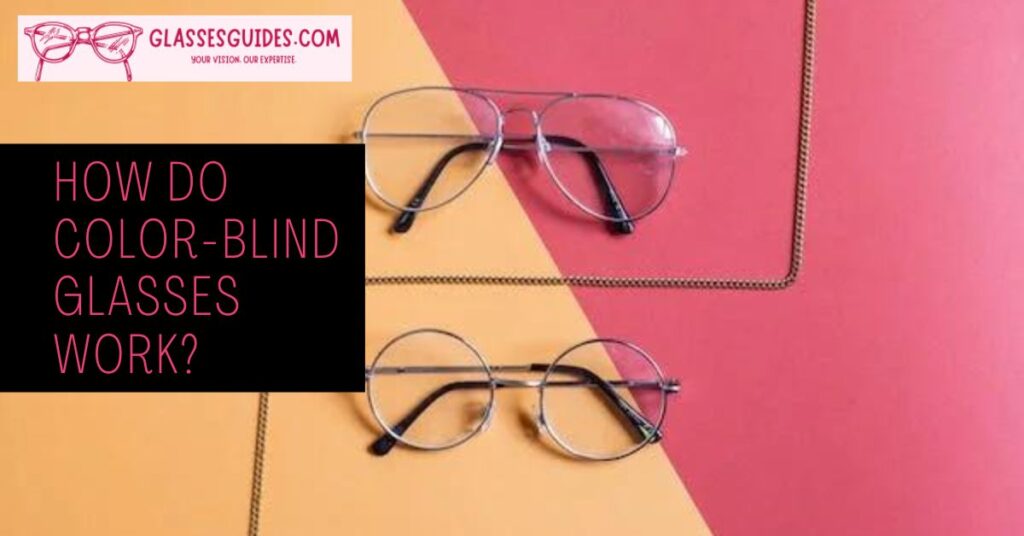Color blindness, also known as color vision deficiency, affects a significant portion of the population, making it challenging to distinguish between certain colors. However, there’s hope for those with this condition through the use of color-blind glasses.
These special glasses employ innovative technology to enhance color perception, offering a clearer view of the world for individuals with color vision deficiency. Let’s delve into how color-blind glasses work and how they can make a difference in the lives of those with color blindness.
Table of Contents

The science behind color-blind glasses
The science behind color-blind glasses is fascinating. These glasses utilize specially designed lenses that work in two main ways to improve color perception for individuals with color vision deficiency.
Lenses filter out overlapping light wavelengths
The lenses in color-blind glasses are crafted using unique minerals and dyes. These components are strategically chosen to filter out specific wavelengths of light while allowing others to pass through.
- Filtering out overlapping wavelengths: The overlapping light wavelengths that confuse people with color blindness, especially red-green color blindness, are one of their main obstacles. By obstructing specific red and green wavelengths, these glasses aim to reduce this overlap and facilitate wearer differentiation of the two colors.
Let useful colors through more clearly
Interestingly, by blocking certain wavelengths, these lenses enhance the perception of useful colors. For instance, while filtering out middle wavelengths, they allow pure reds and greens to pass through more clearly. This separation of colors helps improve the ability to differentiate between them.
Different lenses for different types of color blindness
Depending on which color cones in the eye are damaged, color blindness can take many different forms. Different lenses are made to target the particular wavelengths that cause problems for each type of color blindness to address this variability.
There are specialized treatments available to enhance color perception, regardless of red-green or blue-yellow color blindness. The efficacy of these lenses in treating color vision deficits depends on an understanding of the science underlying them.

Using color-blind glasses
color-blind glasses offer a promising solution for improving color perception, but their effectiveness relies on proper selection and usage. Here’s how they are utilized:
Testing color vision to select proper lenses
Before obtaining color-blind glasses, it’s essential to undergo color vision testing conducted by optometrists or eye care professionals. These tests diagnose the type and severity of color blindness, providing crucial insights into which wavelengths need filtering to enhance color perception effectively.
- Diagnosing type and severity: Color vision tests help determine the specific deficiencies in color perception, such as red-green or blue-yellow color blindness, and assess the severity of the condition.
- Tailoring lenses to individual needs: Based on the test results, optometrists can recommend color-blind glasses with lenses customized to address the unique color perception challenges of each individual. By precisely targeting problematic wavelengths, these lenses maximize the improvement in color vision.
Proper testing ensures that the selected lenses are optimized for the individual’s specific color vision needs, enhancing the effectiveness of color-blind glasses in daily use.
Further reading: What do computer glasses do?
Wearing the glasses as needed
Once the appropriate color-blind glasses with tailored lenses have been obtained, wearing them correctly is crucial for experiencing the benefits of improved color perception.
- Wearing for enhanced color perception: Color blind glasses should be worn whenever enhanced color perception is desired or necessary. Whether it’s enjoying vibrant artwork, identifying color-coded information, or experiencing the beauty of nature, wearing glasses can significantly enhance the visual experience.
- Temporary effects: It’s important to note that the effects of color-blind glasses are temporary and last only while the glasses are worn. Removing the glasses returns color perception to its original state. Therefore, consistent use is key to maintaining the improvement in color vision.
- Practice and adaptation: With regular use, some individuals may experience improved color discrimination even without wearing the glasses. This adaptation occurs through practice and training the brain to differentiate between colors more effectively. However, the glasses remain a valuable tool for enhancing color perception in various situations.
Limitations and considerations
While color-blind glasses offer significant benefits in improving color perception for individuals with color vision deficiency, it’s essential to recognize their limitations and consider certain factors:
- Individual variability: The results and benefits of color-blind glasses can vary greatly from person to person, depending on factors such as the type and severity of color blindness. While some individuals may experience a substantial improvement in color perception, others may only notice minor changes or no improvement at all.
- Not a full cure: It’s important to understand that color-blind glasses do not provide a complete cure for color vision deficiency. While they can enhance color discrimination and make certain colors more distinguishable, they do not restore normal color vision. Colors may still appear dull or different compared to how individuals with normal color vision perceive them.
- Continued color confusion: Despite wearing color-blind glasses, some degree of color confusion may still occur, especially in challenging situations or for individuals with severe color vision deficiency. While the glasses can improve color perception, they may not eliminate color confusion in all circumstances.
- Complementary precautions: Color-blind glasses should be viewed as a complementary aid rather than a standalone solution for managing color blindness. Individuals with severe color vision deficiency should continue to take other precautions, such as relying on color-independent cues or using assistive technologies, to navigate daily tasks effectively.
Conclusion
To wrap it up, color-blind glasses are a useful tool for improving color perception in people who have low color vision. These glasses can dramatically increase the capacity to discriminate between colors by blocking out particular light wavelengths and addressing the particular difficulties associated with various forms of color blindness. But it’s important to understand their limits, which include individual differences in effectiveness and the fact that they don’t offer a full recovery for color vision deficit.
By understanding the science behind these glasses, undergoing proper testing to select appropriate lenses, wearing the glasses as needed, and acknowledging their limitations, individuals can make the most of this innovative technology to experience a more vibrant visual environment.
FAQ: How do color-blind glasses work?
Can color-blind glasses cure color blindness?
No, color-blind glasses do not provide a cure for color blindness. They can improve color perception by filtering out specific wavelengths of light, but they do not restore normal color vision.
How do I know if color-blind glasses will work for me?
Color-blind glasses are most effective for individuals with red-green color blindness, but they can also benefit those with other types of color vision deficiency. Optometrists conduct color vision tests to determine the type and severity of color blindness and recommend appropriate lenses based on the results.
Can I wear color-blind glasses all the time?
Color-blind glasses should be worn whenever enhanced color perception is desired or necessary. However, it’s important to understand that the effects of the glasses are temporary and only last while they are worn.
Will color-blind glasses completely eliminate color confusion?
While color-blind glasses can significantly improve color perception, some degree of color confusion may still occur, especially in challenging situations or for individuals with severe color vision deficiency. The glasses should be viewed as a complementary aid rather than a complete solution for managing color blindness.



